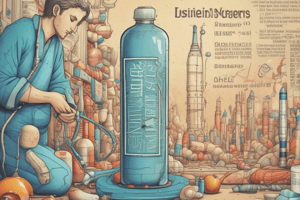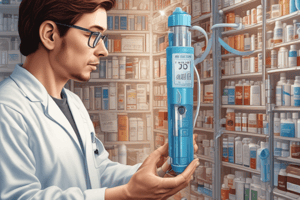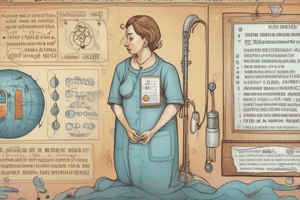Podcast
Questions and Answers
What type of diabetes requires insulin injections for management?
What type of diabetes requires insulin injections for management?
- Type I diabetes (correct)
- Gestational diabetes
- Type II diabetes
- Prediabetes
Which of the following symptoms is NOT associated with hyperglycemia?
Which of the following symptoms is NOT associated with hyperglycemia?
- Polyphagia
- Shaky hands (correct)
- Polydipsia
- Polyuria
What is a common action a pharmacist should take for a patient presenting hypoglycemia with a blood glucose level of 4 mmol/L?
What is a common action a pharmacist should take for a patient presenting hypoglycemia with a blood glucose level of 4 mmol/L?
- Administer long-acting insulin
- Provide fast-acting carbohydrates (correct)
- Advise the patient to eat a high-carb meal
- Suggest increasing daily exercise
At what fasting plasma glucose (FPG) level is hyperglycemia indicated?
At what fasting plasma glucose (FPG) level is hyperglycemia indicated?
Which age group is most commonly affected by Type I diabetes?
Which age group is most commonly affected by Type I diabetes?
What is the primary action of DPP-4 inhibitors in the treatment of type 2 diabetes mellitus?
What is the primary action of DPP-4 inhibitors in the treatment of type 2 diabetes mellitus?
Which DPP-4 inhibitor is safe to use in patients with a creatinine clearance of 15 ml/min?
Which DPP-4 inhibitor is safe to use in patients with a creatinine clearance of 15 ml/min?
DPP-4 inhibitors act by inhibiting which enzyme?
DPP-4 inhibitors act by inhibiting which enzyme?
What is a common reason for using DPP-4 inhibitors in patients with type 2 diabetes?
What is a common reason for using DPP-4 inhibitors in patients with type 2 diabetes?
In the incretin pathway, DPP-4 inhibitors primarily affect which process?
In the incretin pathway, DPP-4 inhibitors primarily affect which process?
What primary role does the PPAR-γ receptor play in the action of thiazolidinediones?
What primary role does the PPAR-γ receptor play in the action of thiazolidinediones?
Which of the following is a noted warning for the use of thiazolidinediones?
Which of the following is a noted warning for the use of thiazolidinediones?
Under what condition should thiazolidinediones not be initiated?
Under what condition should thiazolidinediones not be initiated?
What side effect is commonly associated with the use of thiazolidinediones?
What side effect is commonly associated with the use of thiazolidinediones?
Which of the following contraindications applies to thiazolidinediones?
Which of the following contraindications applies to thiazolidinediones?
What is the primary difference between biologics and biosimilars?
What is the primary difference between biologics and biosimilars?
How should insulin be stored to maintain its effectiveness?
How should insulin be stored to maintain its effectiveness?
What does the '30/70' notation in premixed insulin signify?
What does the '30/70' notation in premixed insulin signify?
What should be done if insulin shows turbidity or cloudiness?
What should be done if insulin shows turbidity or cloudiness?
What type of insulin is not included in the premixed insulin categories mentioned?
What type of insulin is not included in the premixed insulin categories mentioned?
What is the primary mechanism of action of alpha-glucosidase inhibitors?
What is the primary mechanism of action of alpha-glucosidase inhibitors?
How do alpha-glucosidase inhibitors affect the absorption of carbohydrates?
How do alpha-glucosidase inhibitors affect the absorption of carbohydrates?
Which type of sugar absorption is directly impacted by alpha-glucosidase inhibitors?
Which type of sugar absorption is directly impacted by alpha-glucosidase inhibitors?
What is one potential outcome of using alpha-glucosidase inhibitors in diabetic treatment?
What is one potential outcome of using alpha-glucosidase inhibitors in diabetic treatment?
What effect do alpha-glucosidase inhibitors have on starch?
What effect do alpha-glucosidase inhibitors have on starch?
What is the duration of action for RAPID insulin?
What is the duration of action for RAPID insulin?
Which insulin type peaks at 2 to 3 hours after administration?
Which insulin type peaks at 2 to 3 hours after administration?
Which of the following insulins is classified as RAPID?
Which of the following insulins is classified as RAPID?
How many hours does NPH insulin last?
How many hours does NPH insulin last?
What is the onset time for Regular (R) insulin?
What is the onset time for Regular (R) insulin?
What is the peak time for NPH insulin?
What is the peak time for NPH insulin?
Which insulin type is suitable for intravenous dosing?
Which insulin type is suitable for intravenous dosing?
What effect does RAPID insulin have after being taken at mealtime?
What effect does RAPID insulin have after being taken at mealtime?
What is a common side effect of insulin and antidiabetic drugs that affects a significant percentage of patients?
What is a common side effect of insulin and antidiabetic drugs that affects a significant percentage of patients?
Which condition is a contraindication for the use of metformin?
Which condition is a contraindication for the use of metformin?
What serious condition can occur due to the accumulation of metformin in patients with certain health issues?
What serious condition can occur due to the accumulation of metformin in patients with certain health issues?
What is one common factor that increases the risk of lactic acidosis in patients taking metformin?
What is one common factor that increases the risk of lactic acidosis in patients taking metformin?
How does excessive alcohol intake affect metformin treatment?
How does excessive alcohol intake affect metformin treatment?
Which insulin type is characterized by its ability to mimic long-acting effects and last up to 24 hours?
Which insulin type is characterized by its ability to mimic long-acting effects and last up to 24 hours?
What is a crucial characteristic of Glargine (Lantus) that distinguishes it from other insulins?
What is a crucial characteristic of Glargine (Lantus) that distinguishes it from other insulins?
Which insulin is specifically recommended for emergency management of hyperglycemic crisis?
Which insulin is specifically recommended for emergency management of hyperglycemic crisis?
What identifies the action profile of long-acting insulin?
What identifies the action profile of long-acting insulin?
How often is Degludec (Tresiba) administered?
How often is Degludec (Tresiba) administered?
What potential effect does a double dosage of regular insulin have on an individual?
What potential effect does a double dosage of regular insulin have on an individual?
When should rapid insulin be administered in relation to meals?
When should rapid insulin be administered in relation to meals?
Which of the following statements about basal insulin administration is true?
Which of the following statements about basal insulin administration is true?
Which of the following classes of drugs increases insulin secretion from the pancreas?
Which of the following classes of drugs increases insulin secretion from the pancreas?
What is a common side effect of Sulfonylureas?
What is a common side effect of Sulfonylureas?
What is the mechanism of action for Biguanides like Metformin?
What is the mechanism of action for Biguanides like Metformin?
DPP-4 inhibitors enhance which hormone?
DPP-4 inhibitors enhance which hormone?
Which of the following is a contraindication for using 1st Generation Sulfonylureas?
Which of the following is a contraindication for using 1st Generation Sulfonylureas?
Which drug class does not primarily function by increasing insulin secretion?
Which drug class does not primarily function by increasing insulin secretion?
Which of the following classes is an agonist of PPAR-gamma?
Which of the following classes is an agonist of PPAR-gamma?
Which of the following medications is a 2nd generation Sulfonylurea?
Which of the following medications is a 2nd generation Sulfonylurea?
What is a key advantage of meglitinides over sulfonylureas?
What is a key advantage of meglitinides over sulfonylureas?
What is a significant risk associated with glyburide?
What is a significant risk associated with glyburide?
Which of the following statements regarding the therapeutic use of sulfonylureas is correct?
Which of the following statements regarding the therapeutic use of sulfonylureas is correct?
What monitoring is essential for patients on sulfonylureas?
What monitoring is essential for patients on sulfonylureas?
What is a contraindication for the use of meglitinides?
What is a contraindication for the use of meglitinides?
Flashcards
Type I Diabetes
Type I Diabetes
Insulin-dependent diabetes; usually begins in young people and is treated with insulin injections.
Hyperglycemia
Hyperglycemia
High blood sugar levels (FPG >6.5 mmol/L) characterized by increased urination, thirst, hunger, and fatigue.
Hypoglycemia
Hypoglycemia
Low blood sugar (<7 mmol/L); symptoms like sweating, palpitations, and shakiness.
Fasting Plasma Glucose (FPG)
Fasting Plasma Glucose (FPG)
Signup and view all the flashcards
Hypoglycemia Treatment (4 mmol/L)
Hypoglycemia Treatment (4 mmol/L)
Signup and view all the flashcards
Premixed Insulin
Premixed Insulin
Signup and view all the flashcards
Insulin Storage
Insulin Storage
Signup and view all the flashcards
Insulin Biosimilar
Insulin Biosimilar
Signup and view all the flashcards
Biologic vs. Biosimilar
Biologic vs. Biosimilar
Signup and view all the flashcards
Insulin Turbidity
Insulin Turbidity
Signup and view all the flashcards
DPP-4 Inhibitors
DPP-4 Inhibitors
Signup and view all the flashcards
Incretin Hormones
Incretin Hormones
Signup and view all the flashcards
DPP-4 Enzyme
DPP-4 Enzyme
Signup and view all the flashcards
Type 2 Diabetes Mellitus (2DM)
Type 2 Diabetes Mellitus (2DM)
Signup and view all the flashcards
Creatinine Clearance (CrCl)
Creatinine Clearance (CrCl)
Signup and view all the flashcards
Thiazolidinediones Mechanism
Thiazolidinediones Mechanism
Signup and view all the flashcards
Thiazolidinedione Therapeutic Effect
Thiazolidinedione Therapeutic Effect
Signup and view all the flashcards
Thiazolidinedione Warning
Thiazolidinedione Warning
Signup and view all the flashcards
Thiazolidinedione Contraindications
Thiazolidinedione Contraindications
Signup and view all the flashcards
Thiazolidinedione Side Effects
Thiazolidinedione Side Effects
Signup and view all the flashcards
Alpha-glucosidase inhibitor
Alpha-glucosidase inhibitor
Signup and view all the flashcards
Mechanism of alpha-glucosidase
Mechanism of alpha-glucosidase
Signup and view all the flashcards
Effect on blood sugar
Effect on blood sugar
Signup and view all the flashcards
Location of alpha-glucosidase
Location of alpha-glucosidase
Signup and view all the flashcards
How alpha-glucosidase works
How alpha-glucosidase works
Signup and view all the flashcards
Long-acting insulin
Long-acting insulin
Signup and view all the flashcards
Detemir (Levemir)
Detemir (Levemir)
Signup and view all the flashcards
Glargine (Lantus)
Glargine (Lantus)
Signup and view all the flashcards
Bolus insulin
Bolus insulin
Signup and view all the flashcards
Basal insulin
Basal insulin
Signup and view all the flashcards
Regular insulin
Regular insulin
Signup and view all the flashcards
Insulin Action Times
Insulin Action Times
Signup and view all the flashcards
Hypoglycemic symptoms
Hypoglycemic symptoms
Signup and view all the flashcards
Rapid-Acting Insulin
Rapid-Acting Insulin
Signup and view all the flashcards
Regular Insulin
Regular Insulin
Signup and view all the flashcards
NPH Insulin
NPH Insulin
Signup and view all the flashcards
Insulin Duration
Insulin Duration
Signup and view all the flashcards
Insulin Onset
Insulin Onset
Signup and view all the flashcards
Insulin Peak
Insulin Peak
Signup and view all the flashcards
Insulin Usage
Insulin Usage
Signup and view all the flashcards
Rapid Insulin Types
Rapid Insulin Types
Signup and view all the flashcards
Sulfonylureas 2nd Gen
Sulfonylureas 2nd Gen
Signup and view all the flashcards
Meglitinides (e.g., Repaglinide)
Meglitinides (e.g., Repaglinide)
Signup and view all the flashcards
Metformin (Biguanide) Mechanism
Metformin (Biguanide) Mechanism
Signup and view all the flashcards
Sulfonylureas Risk
Sulfonylureas Risk
Signup and view all the flashcards
Meglitinide Administration
Meglitinide Administration
Signup and view all the flashcards
Sulfonylureas (1st Gen)
Sulfonylureas (1st Gen)
Signup and view all the flashcards
Metformin (Biguanide)
Metformin (Biguanide)
Signup and view all the flashcards
SGLT2 Inhibitors
SGLT2 Inhibitors
Signup and view all the flashcards
GLP-1 Enhancers
GLP-1 Enhancers
Signup and view all the flashcards
DPP-4 Inhibitors
DPP-4 Inhibitors
Signup and view all the flashcards
Thiazolidinediones
Thiazolidinediones
Signup and view all the flashcards
α-glucosidase Inhibitors
α-glucosidase Inhibitors
Signup and view all the flashcards
Meglitinides
Meglitinides
Signup and view all the flashcards
Metformin Therapeutic Use
Metformin Therapeutic Use
Signup and view all the flashcards
Metformin Side Effects
Metformin Side Effects
Signup and view all the flashcards
Metformin Lactic Acidosis Risk
Metformin Lactic Acidosis Risk
Signup and view all the flashcards
Metformin Contraindications
Metformin Contraindications
Signup and view all the flashcards
Metformin Drug Interactions
Metformin Drug Interactions
Signup and view all the flashcards
Study Notes
Insulin and Antidiabetic Drugs
- Two types of diabetes mellitus exist: type I and type II.
- Type I diabetes is also known as insulin-dependent diabetes mellitus (IDDM).
- Type I diabetes usually begins in younger people under 40 and of normal weight.
Hyperglycemia
- Fasting plasma glucose (FPG) >6.5 mmol/L
- Symptoms include: polyuria, polydipsia, polyphagia, and fatigue.
Hypoglycemia
- FPG <4 mmol/L
- Symptoms include: sweating, shaking, tremor, hungry and palpitation, confusion, disorientation, dizziness.
Normal Blood Sugar Levels (BSL)
-
Fasting blood sugar levels 5 to 6 mmol/L (100 mg/dL)
-
Random blood sugar levels 11 mmol/L
-
Post prandial sugar levels
-
HbA1c: normal is 4 to 6%, measures past three months blood sugar levels.
-
Treatment of diabetes begins if HbA1c >6.5% and FPG >7 mmol.
Studying That Suits You
Use AI to generate personalized quizzes and flashcards to suit your learning preferences.




